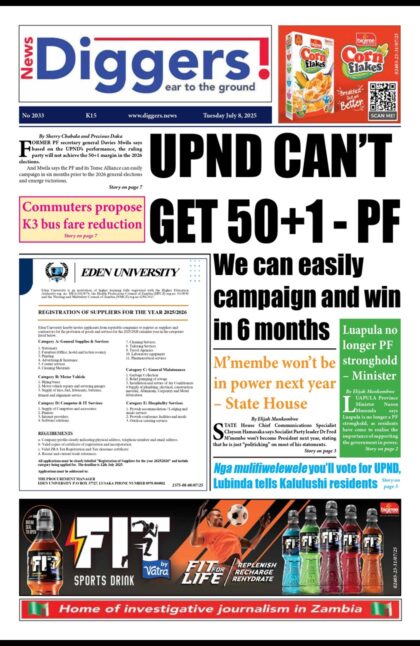CONSUMER Unity and Trust Society (CUTS) Centre Director Dr Claudia Pollen says the persistent depreciation of the Kwacha signifies serious structural imbalances in the domestic economy.
And Dr Pollen has disclosed that the youth unemployment rate increased from 44.3 percent in 2019 to 45.5 percent in 2020.
During a media briefing, Wednesday, Dr Pollen said persistent depreciation of the Kwacha also meant that Zambia had faced relatively expensive imports from abroad.
“Two key indicators of the macroeconomic stability of an economy are the inflation rate and the exchange rate. Other than in two years (2010 and 2017), the kwacha depreciated by various magnitudes relative to the US dollar. The persistent depreciation of the kwacha signifies serious structural imbalances in the domestic economy whereby foreign exchange inflows (largely export earnings) have generally not been strong enough to offset the foreign exchange outflows (mainly to pay for imports and service external debt),” she said.
“The persistent depreciation also means that Zambia has faced relatively expensive imports from abroad, a significant portion of which go into domestic production as imported inputs; this has resulted in imported cost-push inflation. And while a weak local currency would typically prop up and encourage exports, in the Zambian case, the export supply response to the weak kwacha was weak due to persistent supply-side constraints.”
Dr Pollen stated that the agricultural sector’s contribution to the country’s GDP had been declining from 9.6 percent in 2011 to 2.7 percent by 2020, despite it being a key sector in economic growth and poverty reduction.
“We, the Civil Society Organizations, are concerned about Zambia’s economic performance over the past year and in recent months. Since the peak, real Gross Domestic Product (GDP) and per capita GDP growth rates of 10.3% and 7.1%, respectively, in 2010, growth has declined considerably over the past 10-11 years in Zambia. By 2019 – pre-COVID – the real GDP growth rate was down to a meager 1.4% and the per capita growth rate was negative 1.5%, both suggesting serious deterioration in economic growth conditions in the country. With the COVID-19 pandemic in 2020, the real GDP growth rate was negative 2.9% (Zambia Statistical Agency (Zamstats). These developments have had real consequences in the economy. Additionally, the World Bank (2020) indicates that the poverty rate increased from 58.6 percent in 2019 to 60.5 percent in 2020, implying that about 706,900 additional people fell into poverty in 2020,” she said.
“Agriculture, one of the key priority sectors in economic growth and poverty reduction, yet its contribution to GDP has been declining from 9.6% in 2011 to 2.7% by 2020. A monthly review of Zambia’s macroeconomic stability indicators (over January 2017-August 2021) shows that throughout the period of the COVID-19 pandemic and even before that, food inflation was considerably higher than non-food inflation. From January 2021 until the close of the period in August 2021, the food inflation rate rose sharply, reaching 31.6% in August compared to a non-food inflation rate of 16.3%. Food availability and affordability will be two of the most pressing problems for Zambia during 2021 in the wake of food supply chain disruptions that have been further necessitated by on-going COVID-19 pandemic.”
And Dr Pollen disclosed that youth unemployment rate increased from 44.3 percent to 45.5 percent in 2020.
“At a microeconomic level, with a history of low public investments in private sector development for a long time before 2020, during the COVID-19 pandemic, Zambia continued to experience a rise in the rates of unemployment. The overall unemployment rate, which was already high, increased from 35.9% in Q1:2020 to 37.3% in Q2:2020). The youth unemployment rate saw worse outcomes, increasing from 44.3% in Q1:2020 to 45.5% in Q2:2020. Youth unemployment is therefore one of the most pressing challenges for Zambia going forward,” she said.
“Following a national survey conducted by CUTS and fielded by IPSOS in July 2021, we were able to assess the economy, public debt and the impact on Zambians. The survey revealed that 74% of the respondents’ household’s economic situation in the last twelve months has worsened. Additionally, most people had been worried about prices and salaries, employment and the management of COVID-19 in Zambia. In terms of businesses, 59% of small business owners indicated that they were concerned about reduced profits. Other major concerns raised are that business owners had fewer customers and that businesses could not expand. The survey also looked at how citizens felt they were affected by public debt and most respondents were concerned about debt resulting in higher prices, taxes and fees and state asset sales. This shows that debt and the state of the economy have become a worrying issue for Zambians and needs immediate action.”
Dr Pollen stated that most of the selected expenditure significantly overshot their respective budgetary allocations in the first half of 2021.
“In the first half of 2021, most of the selected expenditure significantly overshot their respective budgetary allocations, with the Farmer Input Support Programme (FISP) getting 5,070% more than was allocated and Strategic Food Reserves (SFR) under the Food Reserve Agency (FRA) getting 365% more than the target. Only External debt service (72% below budget), SCT (24% below budget) and Rural Electrification (42% below budget) recorded lower outturns than had been budgeted for. The overspending was very likely part of the then ruling party’s bid to secure the 2021 elections in August. The fiscal slippages are striking. The effectiveness of these funding outlays in reaching their intended beneficiaries is something a programme audit or evaluation would and should determine,” said Dr Pollen.



















One Response
Thank you for the detailed analysis.will be looking forward to your analysis 3years from now to know how our NDG will perform.Good Luck to NDA.God Bless!!